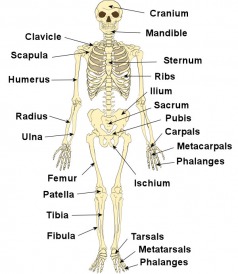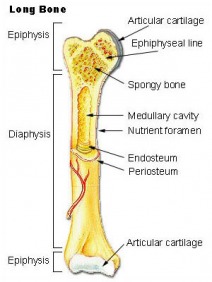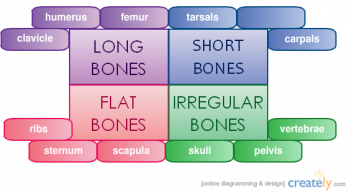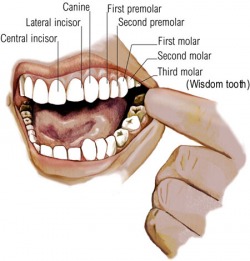The Skeletal System
Functions:
- Provides a framework for the human body
- Protects vital organs
- Allows us to move, lift, reach and throw with muscles, tendons and ligaments
- Produces red blood cells, white blood cells and platelets
- Stores inorganic salts, fats and minerals
- Assists in blood clot formation, conduction of nerve impulses and contraction of muscle cells
- Osteoclasts (bone cells) break down bone tissue, which allows calcium to be released into the blood. If calcium level is too high, osteoblasts form bone tissue – reduces blood level (mineral homeostasis)
- Bones need exercise (thickens bones), hormones (promote formation of bone tissue), Vitamin D (absorbtion of calcium), Vitamin A (shapes bones), and Vitamin C (synthesis of collagen)
Periosteum - Outside layer of bone
Compact Bone – Hard dense layer within periosteum; accounts for 80% of adult skeleton’s bone mass
Spongy Bone – Soft weak layer that surrounds the medullary cavity.
Diaphysis – Shaft of a long bone
Epiphyses – Rounded end of a long bone
Medullary Cavity – Innermost hollow region of a bone where bone marrow is stored. Yellow bone marrow stored at the center contains fat, red bone marrow at the ends form blood cells and platelets.
Joint - Union of two bones
Ligament - Connects two bones together at a joint
Synarthroses (Immovable Joint) - Ex: Skull
Amphiarthroses (Slightly Moveable Joint) - Ex: Ribs and sternum
Diarthrosis (Freely Moveable Joint) - Ex: Ball & Socket (shoulder and hip), Condyloid (metacarpals, metatarsals, phalanges), Saddle (thumb), Pivot (axis and atlas), Hinge (elbow), Gliding (tarsals and carpals)
Compact Bone – Hard dense layer within periosteum; accounts for 80% of adult skeleton’s bone mass
Spongy Bone – Soft weak layer that surrounds the medullary cavity.
Diaphysis – Shaft of a long bone
Epiphyses – Rounded end of a long bone
Medullary Cavity – Innermost hollow region of a bone where bone marrow is stored. Yellow bone marrow stored at the center contains fat, red bone marrow at the ends form blood cells and platelets.
Joint - Union of two bones
Ligament - Connects two bones together at a joint
Synarthroses (Immovable Joint) - Ex: Skull
Amphiarthroses (Slightly Moveable Joint) - Ex: Ribs and sternum
Diarthrosis (Freely Moveable Joint) - Ex: Ball & Socket (shoulder and hip), Condyloid (metacarpals, metatarsals, phalanges), Saddle (thumb), Pivot (axis and atlas), Hinge (elbow), Gliding (tarsals and carpals)




